Landmine Monitor 2020
Support for Mine Action
Jump to a specific section of the chapter:
2019 Key Figures | Intl Contributions | Ntl Contributions | Five-Year Support
Introduction
Article 6 of the Mine Ban Treaty on international cooperation and assistance recognizes the right of each State Party to seek and receive assistance from other States Parties in order to fulfill its treaty obligations.
At the Oslo Review Conference, in November 2019, States Parties committed to complete their respective time-bound obligations by 2025 and to ensure sustainable and integrated support for victims. The Oslo Action Plan contains six action points, along with a series of specific indicators, aimed at tracking progress toward enhancing international cooperation and assistance. These indicators include, among others: the level of national funding; the provision of assistance by States Parties; regular reporting on challenges and needs for assistance; the existence of coordinating mechanisms; and the facilitation of dialogue and information exchange among affected states, the donor community, and other relevant stakeholders. A number of these points have been tracked by the Monitor in the past.
Since 2010, international support totaled about US$5.2 billion, 10% of which was provided in 2019 with 35 donors contributing $561.3 million[1] in support of mine action activities in 41 affected states and other areas. As regards the provision of assistance by and to States Parties, in the last decade, a total of 33 States Parties reported contributing some $1.7 billion in mine action support to 61 affected States Parties. In 2019 alone, 23 States Parties provided $207.7 million in mine action support to 29 States Parties, including $146.9 million to clearance and risk education activities (71% of the total) and $18.8 million to victim assistance (9%).[2] This was the highest level of funding provided by and to States Parties in the 10-year period, and represented about two-fifths of total support provided in 2019. This is an indication of the shared commitment and collaborative spirit and partnership within the mine action community. However, cumulative numbers are just one aspect of the story. The distribution of support among affected states and territories, as well as the sustainability of the assistance, are also key factors.
Tracking national financial commitments by affected States Parties has proven more difficult as a result of under-reporting. Since 2010, the Monitor recorded a total of $1.4 billion provided by affected states to their own mine action efforts.[3] In 2019, only eight out of the 33 States Parties that have declared an identified threat of antipersonnel mine contamination (24%) reported making such financial contributions.[4] National support has more than doubled from the 2018 estimated level, but it has remained below $100 million for four consecutive years. All affected states do not provide the same level of information regarding national resources allocated to mine action activities and some have never done so.
This chapter focuses on financial support for mine action provided for calendar year 2019 by affected countries and international donors. While focused on financial contributions, it remains clear that cooperation and assistance is not only limited to financial assistance. Other forms of assistance can include the provision of equipment, expertise, and personnel, as well as the exchange of experience, know-how, best-practice sharing, and South-to-South or other bilateral and multilateral cooperation.
Total Support to Mine Action
Thirty-five donors and 10 affected states reported contributing $650.7 million in international and national support for mine action in 2019; this is $48.8 million less than the 2018 total (a 7% decrease).
International contributions accounted for 86% of overall support for mine action in 2019, while states’ contributions to their own national mine action programs accounted for the remaining 14% of global funding.
International Contributions
The level of international support for mine action provided by donors declined from $642.6 million in 2018 to $561.3 million in 2019; this is more than $81 million less (a 13% decrease) and continues the drop recorded in the preceding year when international support fell by 8%.
The majority of the funding came from just a few donors, with the top five donors—the United States (US), the European Union (EU), the United Kingdom (UK), Norway, and Germany—contributing a total of $406.7 million, or 72% of all international funding for 2019.
The top five recipient states—Iraq, Afghanistan, Syria, Lao PDR, and Colombia—received a combined total of $276.5 million, representing half of all international contributions (49%).
International funding was distributed among the following sectors: clearance and risk education (56% of all funding), victim assistance (8%), capacity-building (1%), and advocacy (1%). The remaining 34% was either not disaggregated by the donors or unearmarked.
National Contributions
The Monitor identified 10 affected states that provided $89.4 million in contributions to their own national mine action programs, up $32.5 million (a 57% increase) from 2018 when eight affected countries reported contributing $56.9 million.
COVID-19 and mine action international support
The COVID-19 outbreak has presented the mine action community with a new set of unanticipated challenges in 2020. However, as of October 2020, it was too early for most donors to determine the impact of the pandemic on future mine action support levels and potential shifting of their budget priorities.
There were very few reported instances of diversion of mine action funding to address COVID-19 related issues.[5]
International Contributions in 2019
In 2019, 35 donors contributed a total of $561.3 million in international support for mine action in 38 affected states and three other areas—a decline of $81.3 million from the $642.6 million reported in 2018.[6]
This is the second year running that donors decreased their international mine action assistance, and the first time since 2016 that international support dropped below $600 million. In 2019, international support fell more sharply (13%) than in 2018 (8%). However, it still represents the fourth-highest level of international support recorded by the Monitor.[7]
In 2019, the level of international mine action funding collectively provided by the 15 largest donors decreased by $78.2 million.[8] Despite this drop, they continued to provide most of international mine action funding ($538.8 million, 96% of all support).
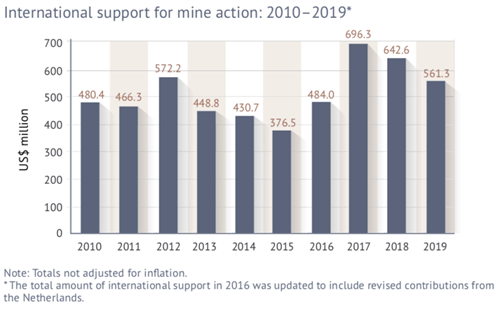
Donors
In 2019, 27 States Parties to the Mine Ban Treaty, three states not party, the EU, and four other institutions[9] contributed a total of $561.3 million to mine action.
In 2019, as in past years, a small group of donors continued to provide the majority of international mine action support. The five largest donors—the US, the EU, the UK, Norway, and Germany—accounted for approximately three-quarters (72%) of all international support with a combined total of $406.7 million.
The US remained the largest mine action donor with $177.4 million and it alone provided more than a fifth (32%) of all international mine action support. The EU ranked second with $76 million, or 14% of all contributions. For the second consecutive year, the UK was the third largest donor with a total contribution of $71.7 million, representing 13% of all support. The next two donors—Norway and Germany—provided more than $35 million each.
Despite variations in the level of support provided, the proportion of total assistance from the top five donors has remained constant in recent years. Between 2015 and 2019, combined contributions from the five major donors ranged between 70–78% of all international support.
Proportion of international mine action assistance by donors: 2018–2019
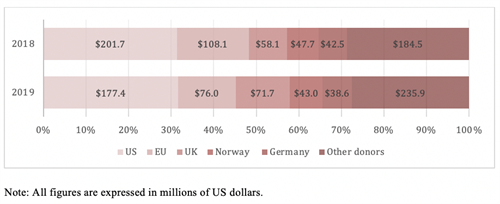
Support from States Parties in 2019 accounted for more than half of all donor funding (54%), with 27 countries providing $301.4 million. This represents a 6% decrease from the $322 million contributed in 2018.
Contributions by donors: 2015–2019[10]
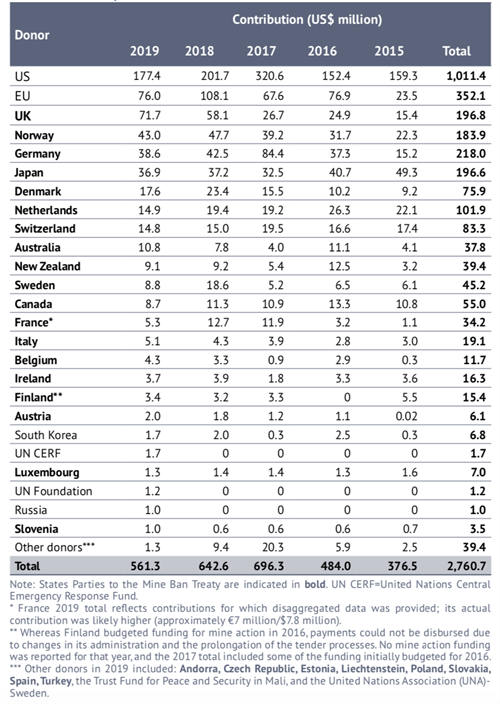
Overall, nine donors contributed more in 2019 than they did in 2018, including a $13.6 million increase from the UK (23%) and a $3 million increase from Australia (38%). The seven other donors increased their assistance by less than $1 million each.
Six donors reported new funding in 2019: Russia, Slovakia, Turkey, the Trust Fund for Peace and Security in Mali, the United Nations Central Emergency Response Fund (UN CERF), and the UN Foundation.
In contrast, 20 donors decreased their funding, led by the EU (down $32.1 million, a 30% decrease) and Sweden (down $9.8 million, a 52% decrease). Additionally, four donors from 2018 did not report any new contribution to mine action in 2019.
Summary of changes in 2019
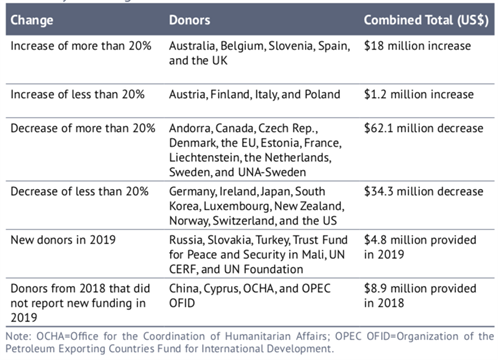
The following table summarizes the changes in mine action funding from the top 15 donors, expressed in their respective national currencies and in US$ terms, and shows the impact of the exchange rates on the US dollar value of international contributions:
- In US dollar terms, mine action international support rose in three countries: Australia, Italy, and the UK. In national currency terms, increases were recorded in the same three countries but were slightly more pronounced.
- Consequently, whereas 12 states reported decreases in their mine action contributions in 2019, after conversion into US dollars, these reductions were greater in percentage terms for nine countries—with the exception of Japan and New Zealand, where the decreases were reduced as a result of exchange rate variation.
Changes in mine action funding in national currency terms and US$ terms[11]
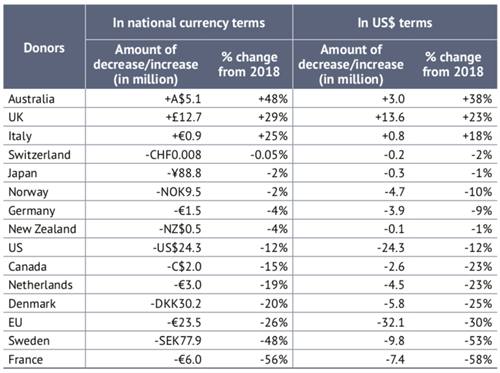
Funding Paths
Donors contributed to mine action through several trust fund mechanisms, notably the UN Voluntary Trust Fund for Assistance in Mine Action (VTF) administered by the United Nations Mine Action Service (UNMAS) and ITF Enhancing Human Security (established by the government of Slovenia and formerly known as the International Trust Fund).
In 2019, contributions through UNMAS totaled $72 million from 26 donors.[12] Several small donors used the VTF to contribute to mine action.[13] At least six donors allocated $4.1 million in 2019 through the ITF for mine action programs.[14]
While donor funding is frequently used for national activities, implementation is often carried out by an array of partnering institutions, non-government organizations (NGOs), trust funds, and UN agencies. Organizations that received a significant proportion of contributions in 2019 included The HALO Trust ($54.1 million), Mines Advisory Group ($39.3 million), the International Committee of the Red Cross ($31.9 million), Norwegian People’s Aid ($26.1 million), DanChurchAid ($23.4 million), the Geneva International Centre for Humanitarian Demining ($12.8 million), Humanity & Inclusion ($12.4 million), and Danish Demining Group ($11.8 million).
Recipients
A total of 38 states and three other areas received $522.6 million from 31 donors in 2019.[15] A further $38.7 million, designated as “global” in the table below, was provided to institutions, NGOs, trust funds, and UN agencies without a designated recipient state or area.
As in previous years, a small number of countries received the majority of funding.[16] The top five recipient states—Iraq, Afghanistan, Syria, Lao PDR, and Colombia—received $276.5 million, or half of all international support in 2019.
Since 2015, Iraq has been the largest recipient of mine action assistance. In 2019, the country received 17% of all international support from the largest number of donors (19). Ten states and one area, or 27% of all recipients, had only one donor.[17]
More than two-fifths of international support (41%, or $231.4 million) went to eight States Parties with massive contamination.[18] Most of this funding, $157.5 million, went to clearance and risk education projects.
List of international support recipients in 2019
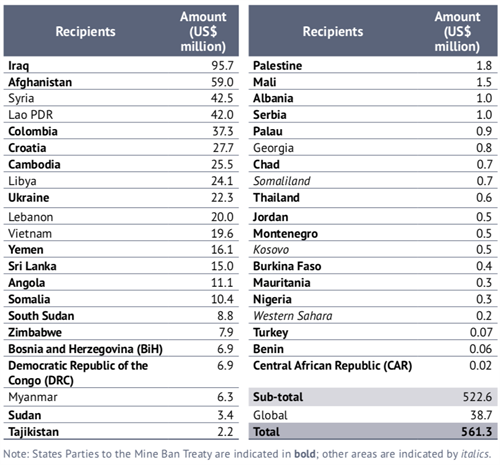
In 2019, 27 states and areas experienced a change of more than 20% in funding compared to 2018, including 15 recipients receiving less support, and 12 recipients receiving more support. In addition, seven previous recipients received no new support: Guinea, the Marshall Islands, Nepal, the Philippines, Senegal, the Solomon Islands, and Tunisia. These fluctuations may reflect shifts in donor priorities and changes in local situations.
Cambodia and Ukraine were the recipients with the largest increases, receiving respectively $11 million and $10 million more than in 2018. These were the results of changes in donors’ contributions, in particular the EU, Japan, the UK, and the US.
It is the second consecutive year that mine action funding channeled to Syria decreased, a fall of $24.2 million in 2019 (36%). The reduction in contribution to mine action activities in the country was the result of sharp decreases in funding from Germany and the US following their exceptional contributions in 2017 (combined increase of more than $67 million). The US has not reported providing new mine action funding to Syria since then, while funding from Germany fell from $13.9 million in 2017 to $4 million in 2019. Croatia was the recipient with the second largest drop in 2019, receiving $22.3 million less than in 2018 after the EU, its sole international donor, reduced its support to clearance activities by half. Both countries remained among the 10 largest recipients of mine action in 2019.
Summary of changes in 2019
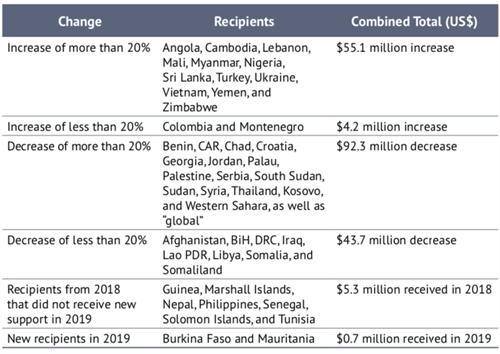
Funding by Thematic Sector
In 2019, 56% of mine action funding supported clearance and risk education activities, while support to victim assistance represented 8% of the total international support to mine action.
“Various” funding represented 34% of all international support to mine action. This includes contributions not disaggregated by the donors, as well as funding not earmarked for any sectors.
Contributions by thematic sector in 2019[19]
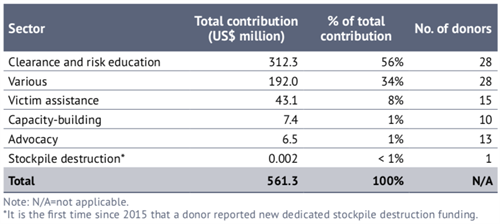
Clearance and risk education
In 2019, $312.3 million, or more than half of all reported support for mine action, went toward clearance and risk education activities. This represents a decrease of $84.6 million from 2018 (21%). The five largest donors—the US, the EU, the UK, Norway, and Germany—provided more than three-quarters of all support to clearance and risk education ($238.9 million).
Many donors reported clearance and risk education as a combined figure. Nineteen donors did, however, indicate contributions specifically for clearance activities, providing a total of $79.3 million in 25 affected countries and two other areas.[20]
Seventeen donors reported contributions totaling $13.3 million specifically for risk education projects in 16 countries.[21] Syria and Iraq received the most risk education-specific funding with a combined total of $7.7 million, more than half of all risk education dedicated support.
Between 2015 and 2019, more than three-fifths of international support went to clearance and risk education activities (61%, or $1.7 billion). Risk education-specific funding represented just 3% of all dedicated support, totaling $43.3 million.
Support from States Parties represented 52% of all dedicated clearance and risk education funding between 2015 and 2019; with more than $883 million provided.[22]
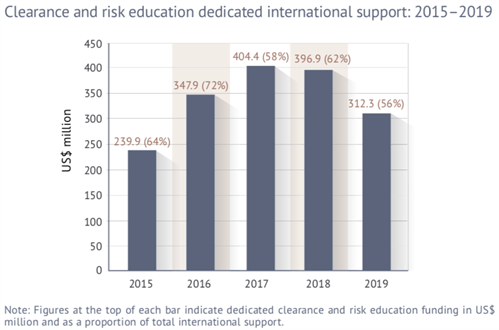
Victim assistance
Based on information available as of October 2020, direct international support for victim assistance activities in 2019 totaled $43.1 million, a 4% decline from the 2018 level ($44.7 million).
Fifteen[23] donors reported contributing to victim assistance projects in 11 States Parties, five states not party, and two other areas.[24] Twelve States Parties contributed a combined total of $28.4 million, representing 66% of all victim assistance funding in 2019.
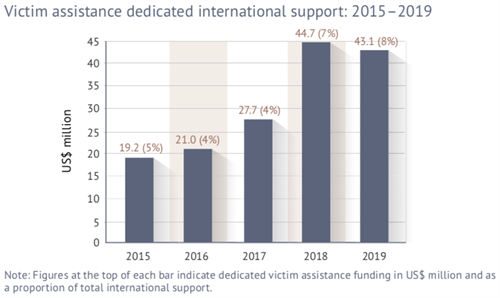
Most mine-affected countries did not receive any direct international support for victim assistance. As observed in 2018, a large part of the contributions from donors to victim assistance activities in 2019 were the result of support within the context of emergency operations in conflict-affected countries in the Middle East and Afghanistan. In 2019, nearly half of all victim assistance support (49%) went to just four countries—Iraq, Syria, Afghanistan, and Yemen—receiving a combined total of $20.8 million.
Approximately $6.6 million, representing 15% of all victim assistance funding, was provided to global activities (without a designated recipient state or area). The remaining 36% went to victim assistance activities in 12 other countries and two other areas, including eight affected States Parties.
As in previous years, a large number of States Parties in which there are significant numbers of victims did not receive any victim assistance support, or very little, whereas needs remained great and available resources were lacking. In 2019, 24 States Parties with significant numbers of victims did not receive such funding,[25] while three States Parties with landmine survivors received less than $500,000.[26]
Funding for victim assistance activities remains especially difficult to track because many donors report that they provide support for victims through more general programs for development and for the rights of persons with disabilities, or are not able to provide specific details on dedicated victim assistance funding. However, this annual estimate still provides an informative picture of the global victim assistance funding situation.
Advocacy and capacity-building
In 2019, just 1% of all reported support for mine action went toward advocacy activities ($6.5 million).[27] Of the 35 donors reporting international contributions to mine action, 13 reported supporting advocacy activities.[28]
Ten donors collectively provided $7.4 million—1% of all international support—to support capacity-building activities in 16 countries.[29]
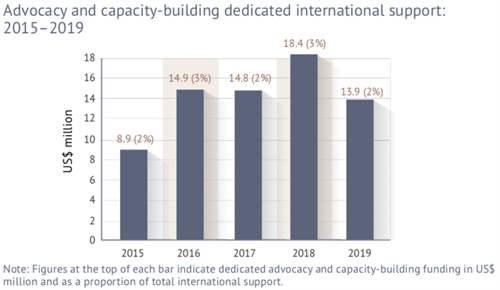
National Contributions in 2019
Overall national contributions to mine action continue to be under-reported. Few States Parties report national funding in their annual Article 7 reports. States Parties such as Iraq and Sri Lanka, as well as states not party India and Vietnam—all mine-affected states with significant contamination and major clearance operations, usually conducted by the army—have never reported annual expenditures.
In 2019, the Monitor identified that at least 10 affected states provided a combined total of $89.4 million in contributions to mine action from their national budget. This is $32.5 million more than the $56.9 million reported in 2018, and similar to the $98.3 million reported in 2017.
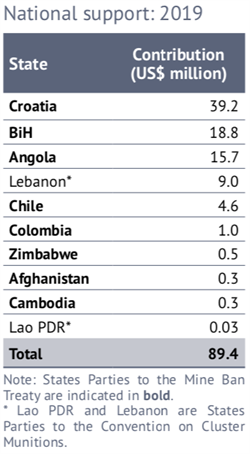
South Sudan and Yemen indicated that national support to their mine action programs has been limited to cover the running costs of their respective mine action authorities, but did not provide details on their levels of contribution.[30] Senegal reported in its most recent Article 5 extension request that it contributed a total of $7.2 million between 2007–2019 to the operational costs of its mine action program.[31]
Five-Year Support to Mine Action 2015–2019
Over the past five years (2015–2019), total support to mine action amounted to $3.2 billion, an average of about $640 million per year. This is $88 million less than the total support provided in the previous five-year period from 2010–2014, constituting a 3% decrease.
Although data about national support remains incomplete, such support accounted for about 14% of total mine action funding between 2015–2019 and amounted to some $460 million. International support totaled $2.8 billion, an average of $560 million per year, and represented 86% of all support.
Three donors—the US ($1 billion), the EU ($352 million), and Germany ($218 million)—contributed $1.6 billion, or 57% of total international support. Four other donors—the UK, Japan, Norway, and the Netherlands—contributed more than $100 million each. Switzerland, Denmark, and Canada, also ranked among the top 10 mine action donors for the five-year period.
Support from States Parties accounted for exactly half of all international funding provided in 2015–2019, with a combined contribution of $1.4 billion.[32]
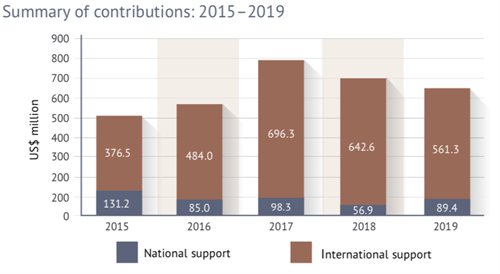
The overall decrease in total support provided in 2015–2019 compared to the previous five-year period was mostly driven by a 50% reduction in national support, which fell from a combined total of $930.6 million reported in 2010–2014 to $460.8 million in 2015–2019. This drop was partly offset by the unusually large 2017 contributions from Germany and the US to support clearance efforts in Iraq and Syria (combined total increase of $204 million). There was also an apparent impact from the series of pledging conferences held in 2016 to secure funding for mine action in some heavily affected countries as well as one-off extraordinary pledges announced around that time.[33] This contributed to significant increases in support received by Colombia (up $111.2 million), Iraq (up $374.3 million), and Lao PDR (up $45 million).
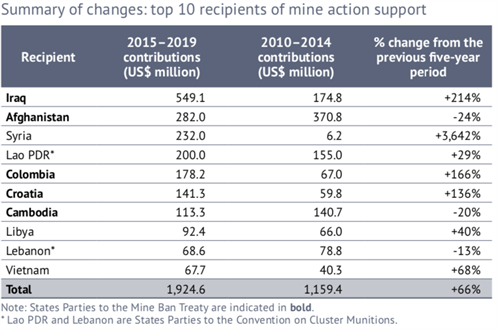
In 2015–2019, the 10 largest recipients of mine action assistance received the majority of available funding, approximately $1.9 billion; this represents on average more than two-thirds (68%) of total international contributions. Of these 10 recipients, four came from the Middle East and North Africa (MENA) region, four from Asia-Pacific, one from the Americas, and one from Europe. The composition of this group of recipients remained relatively similar from one year to another, while there were some variations in the amount of contributions received by each of them from one year to the next.
[1] This figure represents reported government contributions under bilateral and international programs for calendar year 2019, as of October 2020. All dollar values presented in this chapter are expressed in current US dollars. Mine action support includes funding specifically related to landmines, cluster munitions, explosive remnants of war (ERW), and improvised explosive devices (IEDs) but is rarely disaggregated as such. State reporting on contributions is varied in the level of detail and some utilize a fiscal year rather than the calendar year.
[2] The remaining 20% ($42 million) went to advocacy, capacity-building or stockpile destruction activities or was not disaggregated.
[3] This figure includes support provided by affected States Parties to the Mine Ban Treaty and/or to the Convention on Cluster Munitions.
[4] In addition, two states not party, Lao PDR and Lebanon, reported contributing to their own mine action programs in 2019.
[5] Denmark reassigned a United Nations Mine Action Service (UNMAS) contribution for activities in Iraq to address COVID-19 issues while planned disbursement for Tetra Tech projects in Iraq and Syria were delayed. Email from Natascha Hassan Johns, Head of section, Denmark Ministry of Foreign Affairs and Ministry of Defence, 26 June 2020. In April 2020, the Bosnia and Herzegovina (BiH) Council of Ministers decided that EU funds initially allocated to mine action for 2018–2019 would be diverted to address COVID-19 and migration issues. As of June 2020, this was the only instance of diversion of EU funding identified. Email from Frank Meeussen, Disarmament, Non-Proliferation and Arms Export Control, European External Action Service (EEAS), 11 June 2020; and Bosnia and Herzegovina Mine Action Centre (BHMAC); “Ten million EUR intended for humanitarian demining projects in BiH diverted to COVID-19 and migration issues,” 10 April 2020, www.bhmac.org/?p=6343. Finland proposed to its partner organizations to reallocate some mine action contributions to address COVID-19 issues. However as of July 2020, no such request had been made. Email from Anni Mäkeläinen, Desk Officer, Unit for Arms Control, Ministry for Foreign Affairs of Finland, 13 July 2020. No US Agency for International Development (USAID) funding was diverted to address COVID-19, with the exception that a few programs were working with the Ministry of Health to support the development of accessible communications while remaining within the scope of the initial activity of the contributions. Email from Kirsten Lentz, Senior Technical Advisor, Rehabilitation, Technical Support Contract, USAID, Empowerment & Inclusion Division, 16 June 2020.
[6] Data for 2019 on international support to mine action is based on reviews of Mine Ban Treaty Article 7 reports, Convention on Cluster Munitions Article 7 reports, the ITF Enhancing Human Security Annual Report 2019, the UNMAS Annual Report 2019, and answers from donors to questionnaires.
[7] The Monitor maintains records of international support for mine action back to 1996, and national support back to 2002.
[8] The 15 largest donors in 2018–2019 were: the US, the EU, the UK, Norway, Germany, Japan, Denmark, the Netherlands, Switzerland, Sweden, Canada, Australia, New Zealand, France, and Italy. They contributed combined totals of $617 million in 2018 and $538.8 million in 2019.
[9] The three states not party that reported contributions to mine action activities in 2019 were: Russia, South Korea, and the US. The four institutions were the Trust Fund for Peace and Security in Mali, the United Nations Association (UNA)-Sweden, the United Nations Central Emergency Response Fund, and the UN Foundation.
[10] The amount for each donor has been rounded to the nearest hundred thousand. The total amount of international support for 2016 was updated to include a contribution not previously reported by the Netherlands.
[11] Average exchange rates for 2019: A$1=US$0.6952; C$1.3269=US$1; DKK6.6703=US$1; €1=US$1.1194; ¥109.02=US$1; NZ$1=US$0.6591; NOK8.8001=US$1; SEK9.4604=US$1; CHF0.9937=US$1; and £1=US$1.2768. US Federal Reserve, “List of Exchange Rates (Annual),” 2 January 2020, www.federalreserve.gov/releases/G5a/current/default.htm.
[12] In 2019, Switzerland reported in-kind contributions valued at about $387,000 through UNMAS to support operations in Libya and Mali, as well as global activities. Switzerland Convention on Cluster Munitions Article 7 Report, Form I, 28 April 2020, bit.ly/SwitzerlandCCMArt7Report2020.
[13] The small donors (total contribution under $1 million) included Andorra, Estonia, Liechtenstein, Poland, Slovakia, Spain, the Trust Fund for Peace and Security in Mali, and UNA-Sweden.
[14] The six donors were: Austria, the Czech Republic, Slovenia, South Korea, Turkey, and the US.
[15] An additional four donors only reported contributions to “global” activities (without a designated recipient state or area). These donors were: Andorra, Liechtenstein, UNA-Sweden, and UN Foundation.
[16] Of the 10 countries receiving the most mine action funding in 2019, nine were in the top 10 in 2018. Ukraine ranked the ninth largest recipient of mine action support in 2019, replacing Vietnam which became the eleventh largest recipient.
[17] Recipients with one donor included: Albania, Benin, Burkina Faso, Central African Republic (CAR), Croatia, Mauritania, Montenegro, Palau, Serbia, Turkey, and other area, Somaliland.
[18] Massive contamination is defined by the Monitor as more than 100km². Recipients of international support with massive contamination included: Afghanistan, BiH, Cambodia, Croatia, Iraq, Thailand, Turkey, and Yemen.
[19] In 2018, international support was distributed among the following sectors: clearance and risk education ($396.9 million, or 62% of total international support), victim assistance ($44.7 million, or 7%), capacity-building ($14 million, or 2%), advocacy ($4.4 million, or 1%), stockpile destruction ($0 million, or 0%), and various activities ($182.6 million, or 28%).
[20] States Parties recipients of international assistance for clearance were: Afghanistan, Albania, Angola, BiH, Cambodia, Colombia, Croatia, Iraq, Palau, Palestine, Serbia, Somalia, South Sudan, Sri Lanka, Thailand, Ukraine, Yemen, and Zimbabwe. States not party that received international assistance for clearance were: Georgia, Lao PDR, Lebanon, Libya, Myanmar, Syria, and Vietnam. Other areas that received international assistance for clearance activities were: Kosovo and Somaliland.
[21] Recipients of international assistance for risk education were: Afghanistan, Angola, Cambodia, Chad, Iraq, Jordan, Lao PDR, Lebanon, Libya, Mali, Myanmar, Palestine, Syria, Turkey, Ukraine, and Yemen.
[22] In comparison, during the previous five-year period, from 2010–2014, support from States Parties to clearance and risk education activities totaled $966.8 million. This represented 56% of all clearance and risk education dedicated support.
[23] Victim assistance donors included: Australia, Canada, the EU, Germany, Italy, Japan, Liechtenstein, Luxembourg, New Zealand, Norway, Slovenia, Spain, Switzerland, Turkey, and the US.
[24] States Parties recipients of international assistance for victim assistance were: Afghanistan, Cambodia, Colombia, Iraq, Jordan, Mali, Palestine, Somalia, South Sudan, Ukraine, and Yemen. States not party that received international assistance for victim assistance were: Georgia, Lao PDR, Libya, Myanmar, and Syria. And the two other areas were: Kosovo and Western Sahara.
[25] Albania, Algeria, Angola, BiH, Burundi, Chad, DRC, Croatia, El Salvador, Eritrea, Ethiopia, Guinea-Bissau, Mozambique, Nicaragua, Peru, Senegal, Serbia, Sri Lanka, Sudan, Tajikistan, Thailand, Turkey, Uganda, and Zimbabwe.
[26] Cambodia, Jordan, and Mali.
[27] Advocacy activities generally include, but are not limited to: contributions to the Convention on Cluster Munitions and the Mine Ban Treaty Implementation Support Units, the Gender Mine Action Programme (GMAP), the Geneva Centre for Humanitarian Demining (GICHD), Geneva Call, and the ICBL-CMC and its Landmine and Cluster Munition Monitor.
[28] Advocacy donors in 2019 included: Australia, Canada, Czech Republic, Denmark, Germany, Ireland, Italy, Japan, Luxembourg, the Netherlands, Norway, Sweden, and Switzerland.
[29] Recipients of international assistance for capacity-building activities were: Afghanistan, Benin, BiH, Burkina Faso, Cambodia, Chad, Colombia, Iraq, Lao PDR, Lebanon, Mauritania, Palestine, Somalia, South Sudan, Syria, and Ukraine.
[30] South Sudan Mine Ban Treaty Article 5 deadline Extension Request, 27 March 2020, p. 65; and Yemen Mine Ban Treaty Revised Article 5 deadline Extension Request, 8 August 2019, p. 9, bit.ly/YemenRevisedExtRequest2019.
[31] Senegal Mine Ban Treaty Article 5 deadline Extension Request, 15 June 2020, pp. 14–15, bit.ly/SenegalExtensionRequest2020.
[32] Thirty-one States Parties reported support for mine action contributions in 2015–2019: Andorra, Australia, Austria, Belgium, Canada, Cyprus, Czech Republic, Denmark, Estonia, Finland, France, Germany, Ireland, Italy, Japan, Liechtenstein, Lithuania, Luxembourg, Monaco, Netherlands, New Zealand, Norway, Poland, Portugal, Slovakia, Slovenia, Spain, Sweden, Switzerland, Turkey, and the UK.
[33] In 2016, mine action donors reiterated their commitment to secure sufficient resources for mine action efforts in the coming years, notably through two pledging conferences in support of: Iraq (Washington, DC, July 2016) and Colombia (in New York City, September 2016). In 2016–2017, Canada, Germany, the Netherlands, New Zealand, the UK, and the US announced significant increases in their funding to support mine action efforts. See, Monitor factsheet, “Extraordinary Pledges to Support Mine Action in 2016,” 22 November 2016, bit.ly/2016PledgingConferences; and Landmine and Cluster Munition Blog, “Pledges of New Funding in Support of Humanitarian Mine Action,” 13 April 2017, bit.ly/MBT2017Pledgeblog.

